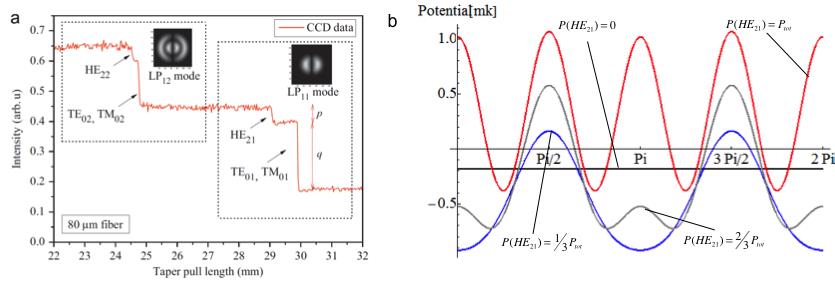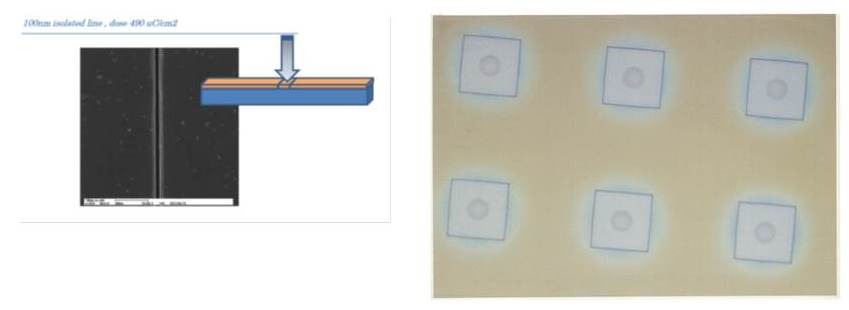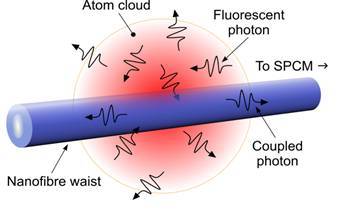FY2012 Annual Report
Light-Matter Interactions Unit
Associate Professor Síle Nic Chormaic

Abstract
We are interested in studying the interaction between light and matter in a number of regimes, including cold atomic systems for advances in the development of quantum-based technologies, whispering gallery mode microresonators for sensing and optomechanics, and optical trapping of biologically relevant specimens. Our primary focus is to gain a better understanding of the processes involved through experiments and to use this knowledge for the manipulation and trapping of micron and submicron particles using light fields. A common technique across our work is the use of optical nanofibers as the interface tool between the light source and the sample under investigation.
We relocated to OIST Graduate University on the 1st October 2012 from University College Cork, Ireland.
1. Staff
- Síle Nic Chormaic, Associate Professor
- Kieran Deasy, Researcher
- Vandna Gokhroo, Researcher
- Ivan Gusachenko, Researcher
- Ciarán Phelan (with Quantum Systems Unit), Researcher
- Vibhuti Bhushan Tiwari, Researcher
- Viet Giang Truong, Researcher
- Jonathan Ward, Researcher
- Yong Yang, Researcher
- Alan Curtis, Technician
- Le Hong Vu, Technician
- Mark Daly, OIST PhD student
- Mary Frawley, UCC/OIST PhD student
- Ravi Kumar, UCC/OIST PhD student
- Ramgopal Madugani, UCC/OIST PhD student
- Aili Maimiati, UCC/OIST PhD student
- Alex Petcu-Colan, UCC MSc Student (UCC)
- Eugen Prel, UCC/OIST MSc student
- Laura Russell, UCC/OIST PhD student
- Malehohonolo Gumede (Poppy Semonyo), UKZN PhD student
- Amy Watkins, UCC PhD Student (UCC)
- Momoko Zamami, Research Administrator (until September 2012)
- Emi Nakamura, Research Administrator (from September 2012)
UCC: University College Cork, Ireland, UKZN: University Kwa-Zulu Natal, South Africa
2. Collaborations
- Theme: Nanofiber Optical Interfaces for Ions, Atoms and Molecules (ended September 2012)
- Type of collaboration: Joint research funded through Nanosci-E+ ERANET program.
- Prof. Arno Rauschenbeutel, TU Wien, Austria
- Prof. Vladimir Minogin, ISAN, Troitsk, Russia
- Profs. Rainer Blatt and Helmut Ritsch, University of Innsbruck, Austria
- Dr. Phil Jones, UCL, London, United Kingdom
- Type of collaboration: Joint research funded through Nanosci-E+ ERANET program.
- Theme: PDMS Microresonators
- Type of collaboration: Joint research
- Prof. Pietro Ferraro, INO-CNR, Italy
- Type of collaboration: Joint research
- Theme: BEC Construction
- Type of collaboration: Joint research
- Dr Michael Morrissey, UKZN, South Africa
- Prof. Francesco Petruccione, UKZN, South Africa
- Malehohonolo Gumede (Poppy Semonyo)
- Type of collaboration: Joint research
- Theme: Quantum Information using Trapped Atoms
- Type of collaobration: Joint research
- Prof. Mikio Nakahara, Kinki University, Japan
- Dr. Elham Hosseini-Lapasar, Osaka City University, Japan
- Type of collaobration: Joint research
3. Activities and Findings
During the time from Oct. 1st , 2012 to March. 31st 2013, a new laboratory was established in OIST Graduate University.
3.1 Higher Order Mode Propagation in Optical Nanofibers for Particle Trapping and Manipulation
The selective excitation of higher order modes, i.e. modes other than the fundamental, in the waist region of a tapered optical nanofiber has been investigated. The LP11 mode is excited in a few mode fiber by coupling a free space Laguerre Gaussian beam to the fiber. The few mode fiber used is chosen based on its core cladding ratio which allows adiabatic propagation of the LP11 mode. The LP11 mode excites the TE, TM and HE21 modes in the waist region. By monitoring the power transmitted through the waist region of the fiber throughout the tapering process the extinction of the HE21 mode has been observed at a certain fiber diameter as a drop in transmission through the fiber (Fig. 1 (a)). By terminating the pulling process just after the extinction of the HE21 a fiber that only allows the TE and TM modes to propagate for a certain wavelength can be fabricated. These results have interesting implications for possible atom trapping experiments using the evanescent field of the nano-fiber. For example, a variation on the red/blue dipole trapping method is possible in which a fiber diameter can be chosen such that the red detuned light can excite the TE and TM with the HE21 while the blue detuned light can excite the TE, TM and HE21.

Figure 1: (a) CCD camera plot showing the evolution of the LP11 mode during tapering of 80mm fiber, at 0.62 mm/s. The drops in intensity correspond to the loss of the modes indicated in the figure. (b) A possible atom trapping potential formed in the evanescent field of a 430nm radius fiber with 1064 nm wavelength TE and TM modes and 700nm wavelength TE, TM and HE21 modes. The figure shows the potential as a function of azimutlal position at a distance of 150 nm from the fiber surface. The fraction of power in the blue detuned beam that propagates in the HE21 mode is indicated.
3.2 Cavity Optomechanics using Whispering Gallery Mode Resonators
3.2.1. Opto-mechanical experimental platform
Besides the taper-microcavity coupling system we had from before, a brand new setup for optomechanics is being built and has been shown to work. This is the first time the Light-Matter Interactions Unit has the capability to do research on this frontier topic since we moved to OIST. A whispering gallery mode (WGM) cavity can contain high intensity photons inside the cavity due to its ultrahigh Q-factor. The photons travelling in the cavity are reflected back off the surface by total internal reflection, which will generate a radiation pressure force on the cavity boundary. Meanwhile, the boundary of the microcavity also oscillates due to thermal fluctuations and material elastic properties. This mechanical oscillation changes the cavity mode and modulates the photons that travel inside. Eventually, the optical modes are coupled with mechanical motion, which, in the language of quantum physics , is a photon-phonon interaction. In order to investigate this interaction, an experimental platform with a homodyne detection scheme has been realized. We tested it with a microsphere resonator made by melting an optical fiber tip. A high sensitive displacement measurement of the boundary oscillation is done by recording the electrical beat note of the transmitted signal from tapered fiber (See Fig. 2).

Figure 2 Left: The scheme of a homodyne detection setup for measuring the mechanical spectrum of a microresonator. Right: The experimental curve is the noise spectrum of a 40 μm diameter microsphere. The peak at 90.2 MHz is the radial breathing mode of this microsphere and the inset is the corresponding vibration shapes from COMSOL simulation.
The success of measuring the mechanical modulation of WGMs shows that our setup can guarantee high precision for research on opto-mechanical systems. We are one step towards implementing a light-matter interface via photon-phonon interaction.
3.2.2. Nanofabrication
In order to achieve a high performance optomechanical system, optomechanical chip design is required. We plan to fabricate micro/nano photonic structures using Silicon-on-Insulator wafer, utilizing OIST's shared physics resources. During FY2012, a micro/nano shape was printed on a PMMA photoresist on top of a silicon wafer by e-beam lithography (Fig. 3).

Figure 3 Left: A disk pattern on PMMA by EBL under microscope. The diameter of the disk is 4μm. Right: Straight waveguide structure by EBL on PMMA. The width of the line is 100nm.
We obtained full experience and parameters to generate designed patterns on photoresist with up to 100 nm precision. Now we are ready for the next step of fabrication for integrated photonic circuits once the ICP is fully functioning.
3.3 Integration of Tapered Optical Fibers into Laser-Cooled Rubidium Clouds
The integration of a tapered (or nano) optical fiber into a cloud of laser-cooled atoms (Fig. 4) provides a unique and non-destructive technique to probe and manipulate those atoms as never before, allowing internal characteristics of the cold atom cloud to be directly observed and exciting prospects such as novel trapping geometries for cold atoms to be explored. Two techniques can be used to probe the cloud using an optical nanofiber within the cold atom cloud and here we present work using both.
Firstly, by collecting fluorescence photons the number of atoms in close proximity to the nanofiber can be determined and using this the average temperature of the laser-cooled atoms has been determined. This was achieved by briefly releasing the cloud from its trapped state, before recapturing it again. During the release time the cloud expands ballistically and those atoms with enough energy, “hot enough”, escape the trapping region entirely. On reactivation of the trap only those atoms with a low enough temperature are recaptured. From the fraction of recaptured atoms the average temperature of the cold atom cloud before measurement can then be determined.
The second technique is to pass a probe beam through the nanofiber, allowing the significant proportion of light guided within the evanescent field to interact with the surrounding atoms. Absorption of the correctly tuned probe light can then be detected. For many experiments of this sort an optical dense medium surrounding the optical nanofiber would be beneficial, which is why we have operated a dark MOT around the nanofiber. Using the higher optical densities it may be possible to observe non-linear effects such as 2-photon absorption or electromagnetically induced transparency.

Figure 4: Schematic of the atom cloud overlapping the nanofibre, illustrating the coupling of fluorescence photons to the guided mode of the fibre.
3.4 Whispering Gallery Mode Resonators for Sensing, Cavity QED and Photonics Applications

Our current work involves optical characterisation and optimisation of the whispering gallery modes in our microbubbles. We are also investigating thermo-optical properties and developing a highly sensitive temperature sensor based on the whisphering gallery modes in the liquid core microbubbles.
3.5 Optical Manipulation and Optical Detection of Biological System
We developed a versatile system for microscopic particle optical manipulation with spectroscopic modalities, based on an optical tweezers setup. By the end of FY2012, the optical tweezers with multitrap capability was installed and tested. Furthermore, the necessary components for the fluorescence and lifetime spectroscopy of biological objects, which are to be installed in FY2013, have been purchased. Following the previously observed optical propulsion of particle chains by a nanofiber (Fig. 6 (a)), we performed numerical simulation of this process (Fig. 6 (b)) and implemented a nanofiber into the optical tweezers setup to study the propulsion phenomenon more accurately.

Figure 6: (a) Chains of 3 µm particles trapped and propelled in the evanescent field of a nanofiber. (b) COMSOL simulation of field distribution and forces acting on particles for a finite chain arrangement.
4. Publications
4.1 Journals
- Madugani, R., Yang, Y., Ward, J. M., Riordan, J. D., Coppola, S., Vespini, V., Grilli, S., Finizio, A., Ferraro, P. & Nic Chormaic, S. Terahertz tuning of whispering gallery modes in a PDMS stand-alone, stretchable microsphere. Optics Letters 37, 4762-4764 (2012).
- Frawley, M. C., Petcu-Colan, A., Truong, V. G. & Nic Chormaic, S. Higher order mode propagation in an optical nanofiber. Optics Communications 285, 4648-4654, doi: DOI 10.1016/j.optcom.2012.05.016 (2012).
- Russell, L., Daly, M. & Nic Chormaic, S. 1- and 2-photon absorption by laser-cooled 85Rb using an optical nanofiber. AIP Conf. Proc. 1469, 82-90 (2012).
- Watkins, A., Ward, J. & Nic Chormaic, S. Thermo-Optical Tuning of Whispering Gallery Modes in Erbium: Ytterbium Doped Glass Microspheres to Arbitrary Probe Wavelengths. Japanese Journal of Applied Physics 51, 052501, doi: DOI 10.1143/Jjap.51.052501 (2012).
- Wu, Y. Q., Ward, J. & Nic Chormaic, S. Observation of thermal feedback on the optical coupling noise of a microsphere attached to a low-spring-constant cantilever. Physical Review A 85, 053820-053821 -053828 doi: Doi 10.1103/Physreva.85.053820 (2012).
- Frawley, M. C., Nic Chormaic, S. & Minogin, V. G. The van der Waals interaction of an atom with the convex surface of a nanocylinder. Physica Scripta 85, 058103, doi: DOI 10.1088/0031-8949/85/05/058103 (2012).
4.2 Books and other one-time publications
Not applicable
4.3 Oral and Poster Presentations
- Nic Chormaic, S., Russell, L., Daly, M. & Tiwari, V. B. Spectroscopic studies using an optical nanofibre in cold Rb, IOP Topical Research Meeting on Quantum Technologies: Taking Concepts through to Implementations, London, UK, December 17, 2012
- Nic Chormaic, S., Frawley, M., Truong, G., Prel, E. & Maimaiti, A. Tapered optical fibres for particle trapping and manipulation, Quantum Africa 2, Northern Drakensberg, South Africa, September 7, 2012
- Russell, L., Kumar, R., Tiwari, V. & Nic Chormaic, S. Optical nanofibres as probes for bright and dark cold atoms, Quantum Africa 2, Northern Drakensberg, South Africa, September 6, 2012
- Kumar, R., Russell, L., Daly, M., Tiwari, V. B. & Nic Chormaic, S. Temperature measurement of cold atoms using transient absorption from an optical nanofibre, ICAP 2012, Paris, France, July 24, 2012
- Nic Chormaic, S. Optical nanofibers as probes for cold atoms, Quantum interfaces: integrating light, atoms and solid-state devices, Milton Keynes, UK, May 14, 2012
5. Intellectual Property Rights and Other Specific Achievements
Not applicable
6. Meetings and Events
6.1 Seminar
- Date: January 23, 2013
- Venue: OIST Campus Centre Building
- Speaker: Prof. Kohzo Hakuta (the University of Electro-Communications, Japan)
- Title: Nanofiber Quantum Photonics: A Novel Route for Manipulating and Controlling Single Atoms and Single Photons
6.2 Seminar
- Date: February 22, 2013
- Venue: OIST Campus Centre Building
- Speaker: Prof. Mikio Nakahara (Kinki University, Japan)
- Title: Aspects of Composite Pulses: Implementing high-precision quantum gates out of low-quality gates
6.3 Seminar
- Date: February 25, 2013
- Venue: OIST Campus Centre Building
- Speaker: Dr Michael Morrissey (University Kwa-Zulu Natal, South Africa)
- Title: Construction of a Bose Einstein Condensation Machine
6.4 Seminar
- Date: March 13, 2013
- Venue: OIST Campus Centre Building
- Speaker: Mr. Chang-Ling Zou, (USTC, China)
- Title: Packaged Silica Microsphere-taper Coupling System for Practical Applications
6.5 Workshop: Quantum @ OIST
- Date: May 7 to 10, 2013
- Venue: OIST Campus Centre Building and Seaside House
7. Others
7.1 Physics Demonstration for Yamada Junior High School students
- Date: January 15, 2013
- Venue: OIST Campus Centre Building



